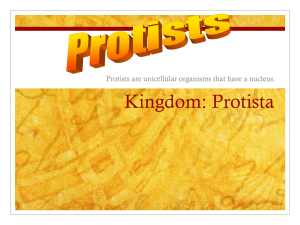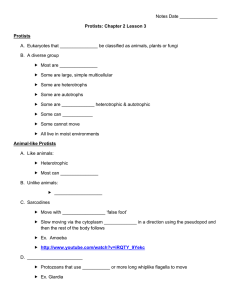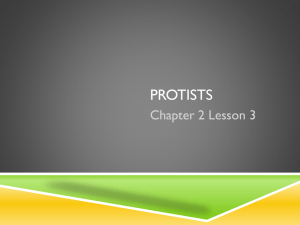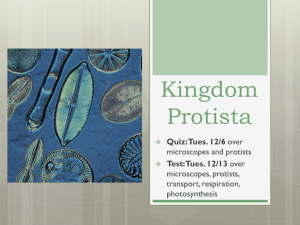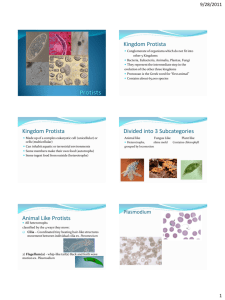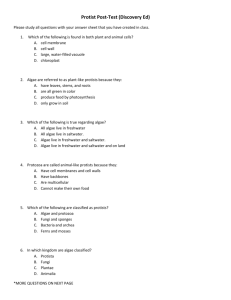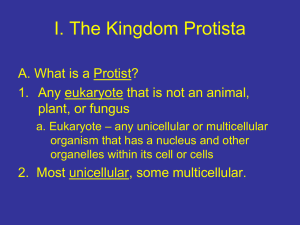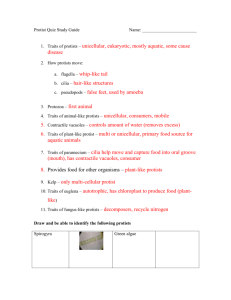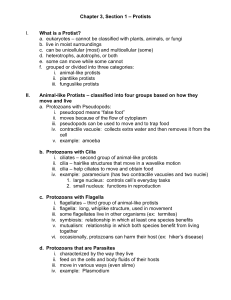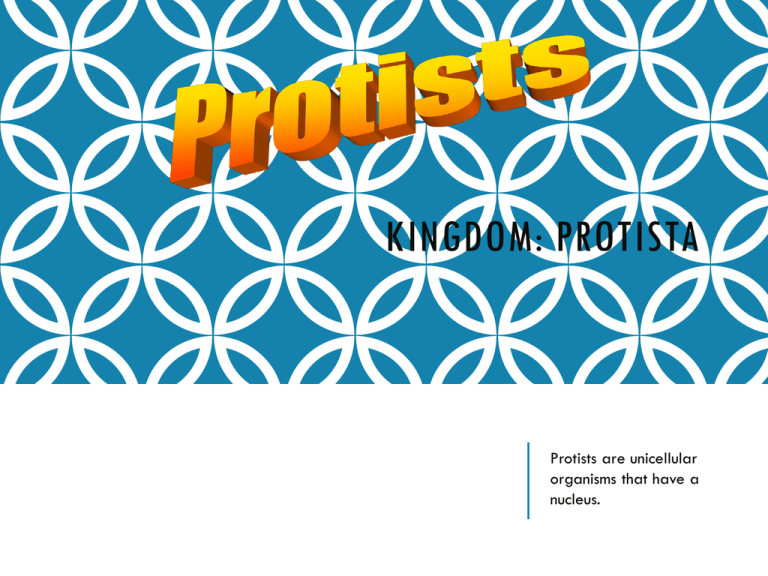
KINGDOM: PROTISTA
Protists are unicellular
organisms that have a
nucleus.
3 CATEGORIES
I. Animal-like Protists.
II. Plant-like Protists.
III. Fungus-like Protists.
I. ANIMAL-LIKE PROTISTS
Protozoan means “First Animal”.
Cells contain a nucleus.
Cells lack a cell wall.
They are heterotrophs.
Most can move on their own.
4 GROUPS OF ANIMAL-LIKE PROTISTS
1. Sarcodines (SAHR-koh-dighnz)
2. Ciliates (SIHL-ee-ihts)
3. Flagellates (FLAJ- ehl-ihts)
4. Sporozoans (spohr-oh-ZOH-uhnz)
1. SARCODINES
Have pseudopods (Greek:“false foot”)
Extensions of the cell membrane and cytoplasm.
Pseudopods are used for movement and to capture food.
Many have shells.
These shells form limestone, marble and chalk.
ONE TYPE:
Most familiar Sarcodine.
Pseudopods:
Blob shaped.
Contractile Vacuoles:
controls amount of water
inside
Food Vacuole: where food
is digested.
SPLIT PERSONALITY
Amebas reproduce by
dividing into two new
cells (binary fission).
Amebas can respond to
their environment.
They are sensitive to light
and some chemicals.
2. CILIATES
Have cilia on the outside
of their cells.
Tiny hair-like projections
used for movement, to
gather food and as
feelers.
TYPE: PARAMECIUM
Pellicle: tough outer wall.
Slipper shaped
Oral groove: like the mouth
Gullet: holds food.
Food Vacuole: digests food.
Anal Pore: removes wastes
2 Contractile Vacuoles
2 Nuclei
Reproduces by either binary
fission or conjugation.
3. FLAGELLATES (ZOOFLAGELLATES)
Have a Flagellum: a long
whip-like structure used for
movement.
Many live in animals
Symbiosis a close
relationship, at least one
benefits.
Mutualism: when both
partners benefit.
4. SPOROZOANS
All Sporozans are parasites.
They feed on cells and body fluids.
Form from Spores (tiny reproductive cells).
Pass from one host to another.
Pass from ticks, mosquitoes or other animals to humans.
II. PLANT-LIKE PROTISTS
(ALGAE)
Unicellular and Multicellular
Colonies (groups of unicellular protists)
Can move on their own
Autotrophs: make their own food from simple materials using light energy
(photosynthesis).
70% of the Earth’s oxygen is produced by Plant-like Protists!
Pigments: chemicals that produce color
6 GROUPS OF PLANT LIKE PROTISTS
Euglenoids (yoo-GLEE-noydz)
Diatoms (DIGH-ah-tahmz)
Dinoflagellates (digh-noh-FLAJ-eh-layts)
Red Algae
Green Algae
Brown Algae
1. EUGLENOIDS
Green
Unicellular
Live in fresh water
Autotrophs, but can be
heterotrophs under certain
conditions.
Flagella
Eyespot: sensitive to light.
Chloroplasts
Pellicle
2. DIATOMS
Unicellular
10,000 living species.
Aquatic
Glass like cell wall
Diatomaceous earth: course
powder that comes from
dead diatoms (toothpaste,
car polish & reflective
paint.
3. DINOFLAGELLATES
Unicellular
Cell walls are like plates of
armor.
Two flagella
Spins when it moves.
Colorful (pigments)
Can glow in the dark.
Causes Red Tide
RED ALGAE
Multicellular seaweeds
Live in deep ocean waters
Used for ice cream and hair
conditioner
Used as food in Asia
GREEN ALGAE
Most are unicellular
Some form colonies
Few are multicellular
Can live in fresh and salt water and
on land in damp places.
Very closely related to green
plants.
BROWN ALGAE
Commonly called seaweed
Can contain brown, green, yellow,
orange and black pigments.
Attach to rocks
Have air bladders
Giant Kelp can be 100 meters
long!
Used as food thickeners
III. FUNGUS-LIKE PROTISTS
Heterotrophs
Have cell walls.
Many have flagella and are able to move at some point in their lives.
Three types: Slime Molds, Water & Downy Molds
Reproduce with Spores (tiny cell that is able to grow into a new organism)
Reproduce by Fruiting
Bodies:
The Fruiting Bodies contain
Spores.
At first they look like ameba,
then later they look like
mold.
Live on moist shady places.
Feed on bacteria and other
microorganisms.
WATER & DOWNY MOLDS
Live in water or moist places.
Tiny threads that look like fuzz.
Attack food crops
Caused the Irish Potato Famine.

